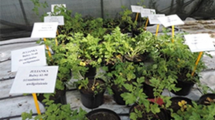Abstract
The neutron probe, infrared thermometry and crop water stress index (CWSI), and a computer-assisted irrigation scheduling method were evaluated in terms of their effect on tuber yield, tuber quality, and water use. The experiment was conducted during 1990 and 1991 near Othello, central Washington, using Russet Burbank potatoes grown in a silt loam soil. Irrigation treatments did not commence until after tuber initiation. In general, no differences in total number of tubers and total tuber yield resulted from the different scheduling methods. However, the canopy temperature method showed reduction in the yield of number one tubers in 1990. The least total irrigation water was applied during the growing season with the neutron probe method. Using CWSI values above 0.5 to 1.0 (scale 0 to 10) for two consecutive days as a threshold to schedule irrigations appeared to be adequate for potatoes grown in silt loam soils. However, shortcomings of infrared thermometry suggested that this method may not be practical for scheduling irrigation of potatoes.
Compendio
La sonda de neutrones, la termometría infraroja y el índice de presión de agua del cultivo, y un método de programación de riegos con apoyo computadorizado fueron evaluados en términos de sus efectos sobre el rendimiento y la calidad de los tubérculos y la utilizatión del agua. Los experimentos fueron conducidos durante 1990 y 1991, cerca de Othello, en el centro de Washington, utilizando papas Russet Burbank cultivadas en un suelo tipo migajón-aluvión. Los tratamientos de riego no se aplicaron hasta después del inicio de la tuberización. En general, no hubieron diferencias en el número total de tubérculos y el rendimiento total en tubérculos en los diferentes métodos de programación. Sin embargo, en 1990, el método de la temperatura del follaje mostró una reducción en el rendimiento de tubérculos #1. La menor cantidad de agua de riego fue aplicada durante la temporada de cultivo con el método de la sonda de neutrones. Utilizando valores CWSI por encima de 0.5 a 1.0 (escala 0 a 10), por dos días consecutivos, como inicio de la programación de riegos para papas cultivadas en suelo migajón-aluvión es aparentemente lo adecuado. Sin embargo, las deficiencias de la termometría infraroja sugieren que este método puede no ser práctico para programar la irrigación de la papa
Similar content being viewed by others
Literature Cited
Adams, S.S. and W.R. Stevenson. 1990. Water management, disease development, and potato production. Am Potato J 67:3–11.
Allen, R.G., M.E. Jensen, J.L. Wright and R.D. Burman. 1989. Operational estimates of reference evapotranspiration. Agron J 81:650–662.
Best, K. and L.G. James. 1988. WIF, Washington Irrigation Forecaster. MCP 006, Cooperative Extension, College of Agriculture and Home Economics, Washington State University.
Doorenbos, J. and W.O. Pruitt. 1977. Crop water requirements. FAO Irrigation and Drainage Paper No. 24. 144 p.
Gardner, B.R., D.C. Nielsen and C.C. Shock. 1992. Infrared thermometry and the crop water stress index. II. Sampling procedures and interpretation. J Prod Agric 5:466–475.
Hane, D.C. and F.V. Pumphrey. 1984. Yield-evapotranspiration relationships and seasonal crop coefficients for frequently irrigated potatoes. Am Potato J 61:661–668.
Idso, S.B., R.D. Jackson, P.J. Pinter, R.J. Reginato and J.L. Hatfield. 1981. Normalizing the stress-degree-day parameter for environmental variability. Agric Meteorol 24:45–55.
Jackson, R.D., S.B. Idso, R.J. Reginato and P.J. Pinter. 1981. Canopy temperature as a crop water stress indicator. Water Resour Res 7:1133–1138.
Jackson, R.D., W.P. Kustas and B.J. Choudhury. 1988. A reexamination of the crop water stress index. Irrig Sci 9:309–317.
James, L.G., J.M. Erpenbeck, D.L. Bassett and J.E. Middleton. 1982. Irrigation requirements for Washington-Estimates and methodology. Agricultural Research Center, Washington State University, Res Bul XB 0925. 37 p.
Jensen, M.E., J.L. Wright and B.J. Pratt. 1971. Estimating soil moisture depletion from climate, crop and soil data. Trans of the ASAE 14(5):954–959.
Jensen, M.E., R.D. Burman and R.G. Allen (eds.). 1990. Evapotranspiration and irrigation water requirements. ASCE Manuals and Reports on Engineering Practice No. 70, ASCE, New York.
Larsen, D.C. 1984. Simplifying potato irrigation scheduling —The Idaho program. Am Potato J 61:215–227.
Ley, T.W. and M.W. Kroeger. 1988. Washington Public Agriculture Weather System. ASAE Paper No. PNR 88-0-106. ASAE, St. Joseph, MI.
Martin, M.W. and D.E. Miller. 1983. Variations in responses of potato germplasm to deficit irrigation as affected by soil texture. Am Potato J 60:671–683.
Stark, J.C. and J.L. Wright. 1985. Relationship between foliage temperature and water stress in potatoes. Am Potato J 62:57–68.
Stockle, CO. and W.A. Dugas. 1992. Evaluating canopy temperature-based indices for irrigation scheduling. Irrig Sci 13:31–37.
Author information
Authors and Affiliations
Additional information
Contribution from the Agriculture Research Center, Washington State University, Pullman, WA 99164. This work was supported in part by the Washington State Potato Commission
Author to whom inquiries and reprint requests should be directed
Mention of a trademark, proprietary product or vendor does not constitute a guarantee or warranty of the product by Washington State University and does not imply its approval or endorsement to the exclusion of other products that may also be suitable
Rights and permissions
About this article
Cite this article
Stockle, C.O., Hiller, L.K. Evaluation of on-farm irrigation scheduling methods for potatoes. American Potato Journal 71, 155–164 (1994). https://doi.org/10.1007/BF02849050
Accepted:
Issue Date:
DOI: https://doi.org/10.1007/BF02849050




